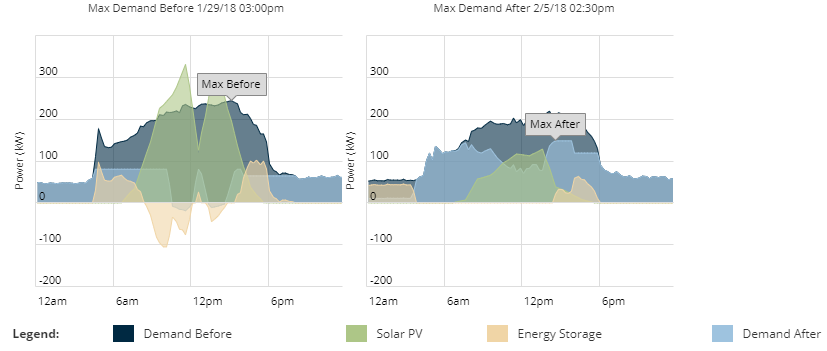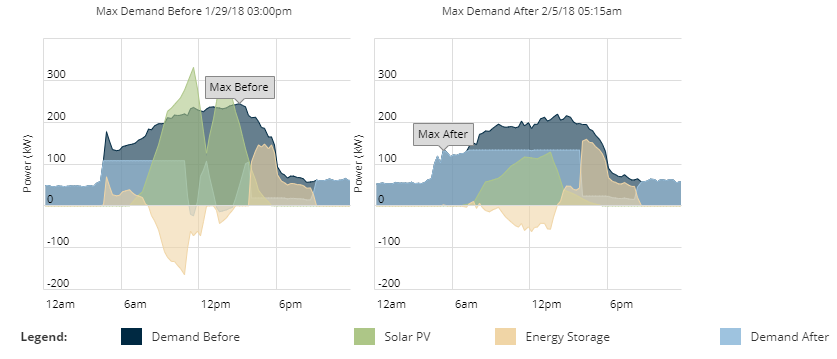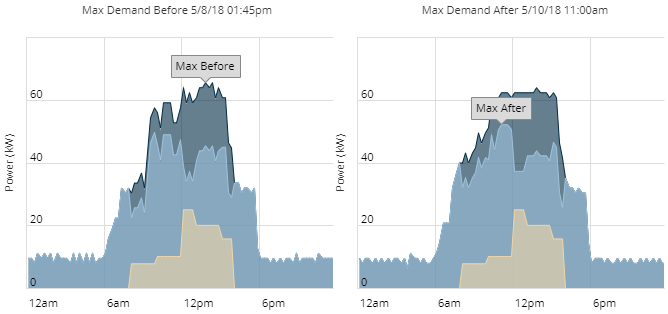Batteries and other energy storage technology can provide significant savings to businesses and homes. They do so by strategically deploying the solar energy you produce at higher priced times. For businesses a battery also decreases the demand charges. For some tax incentives, the battery can only be charged by the solar energy system (or needs at least 75% to be charged by solar). How does a battery know when to charge/discharge the electricity? That depends on what type of battery you get.
Basic Battery: A basic battery is going to collect energy from the solar instead of letting the meter spin backwards. Once it is full, it will let the solar back feed the grid. The battery will then begin to discharge electricity when it sees the solar is not offering enough power to supply the building. Depending on the features, you may be able to tell it when the most expensive time periods are. Overall, this type of battery is good for residential solar because they don't have demand charges. Below is an example of a commercial company's demand profile. On the left side, you can see the green solar production dips at noon when a large cloud passes by. This causes the battery to discharge electricity to limit the demand spike. In the afternoon you can see the beige battery is discharging the electricity at the peak time of 4-9 PM, but it quickly runs out of electricity. The right side shows the battery discharging before 4 PM to limit the peak demand and then fully discharges after 4PM. The battery did not end up having a full charge because of the cloudy day.

Smart Battery: A smart battery is going to perform much better as it is taking many factors into account instead of just the immediate building's energy demand. The brains of the battery though actually come from the software that is controlling the battery and not the battery itself. A smart battery is going to be taking multiple factors into account as it will be watching weather forecasts so it can estimate the solar's production but also the building's air conditioning or heating load. It will then strategize the discharging for these loads to give the client the greatest savings.
Smarter Battery: Stem's energy storage software, Athena, is an AI-powered software. This software is using the building's historical data to predict the loads. It is also using the data from all of it's brothers and sisters that have been installed elsewhere to learn how to maximize its performance. This means the more Stem systems that are installed, the better the battery performs for all Stem customers. The below example is the same demand profile but with an Athena controller. With this particular client, they have a spike every morning around 5:30 AM. The Athena software knows this is going to happen every day and will do its best to keep a charge ready in the battery to offset this because the sun won't be shining yet. The software identifies its maximum demand for the billing period and targets the performance of the battery. This is shown below because the battery created a flat demand curve that allows more charging during cheaper time periods. This allowed there to be more electricity discharged during the most expensive time at 4-9PM.

SunGreen Difference: If you're engaging a company like SunGreen Systems, we brought the morning spike issue up to our client at the proposal meeting. It turns out they have several pieces of HVAC equipment that are scheduled to turn on at that time every day to prepare the building for the employee's arrival later. HVAC systems spike in energy use when they are first turned on which means if you don't turn them all on at once, you'll have a much lower spike in the morning. The client thanked us because this was a simple scheduling change that would lower their morning demand at no cost or impact to building comfort. This would also improve the future performance of the battery as it can focus on unchangeable loads.
Sungreen Efficiency: SunGreen Systems is also going to make sure you have already taken care of the lowest hanging fruit. For example, replacing your lighting with LEDs has a terrific payback of fewer 2 years and sometimes even less than 1 year. An efficient HVAC system also helps reduce your peak load as many business's see their highest peak demands on the hottest days of the year. This also causes a demand reduction as seen below. You can see below the rough estimated impacts of an LED and HVAC upgrade. These upgrades can provide the savings of a basic battery at a much lower cost. When this is then combined with solar and a smarter battery, the returns will have your CFO spinning in his chair.







